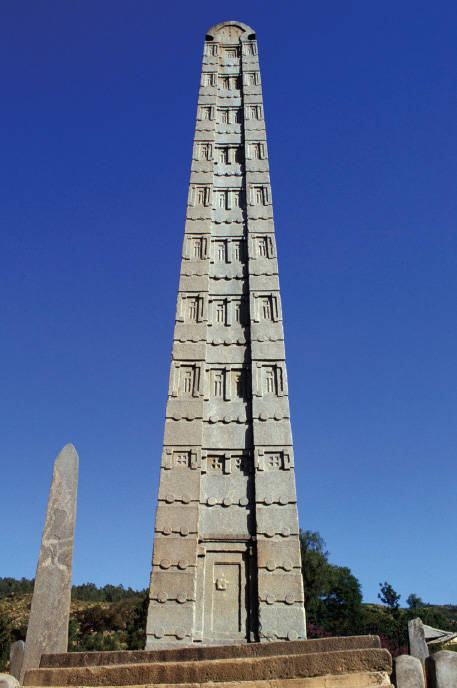Axum: The Making of a Christian Kingdom
If Meroë represented the continuation of an old African/Nubian civilization, Axum marked the emergence of a new one. (For various accounts about or from Axum, see Documents: Axum and the World.) Axum lay in the Horn of Africa, in what is now Eritrea and northern Ethiopia (see Map 6.1). Its economic foundation was a highly productive agriculture that used a plow-based farming system, unlike most of the rest of Africa, which relied on the hoe or digging stick. Axum’s agriculture generated substantial amounts of wheat, barley, millet, and teff, a highly nutritious grain unique to that region. By 50 C.E. or so, a substantial state had emerged, stimulated by its participation in the rapidly increasing Red Sea and Indian Ocean commerce, which was itself a product of growing Roman demand for Indian pearls, textiles, and especially pepper. At Adulis, then the largest port on the East African coast, a wide range of merchants sought the products of the African interior—animal hides, rhinoceros horn, ivory, obsidian, tortoiseshells, and slaves. Taxes on this trade provided a major source of revenue for the Axumite state and the complex society that grew up within it. Thus the decline of Meroë and the rise of Axum were both connected to changing patterns of long-distance commerce.5

The interior capital city, also known as Axum, was a center of monumental building and royal patronage for the arts. The most famous buildings were huge stone obelisks, which most likely marked royal graves. Some of them were more than 100 feet tall and at the time were the largest structures in the world hewn from a single piece of rock. The language used at court, in the towns, and for commerce was Geez, written in a script derived from South Arabia. The Axumite state exercised a measure of control over the mostly Agaw-speaking people of the country through a loose administrative structure focusing on the collection of tribute payments. To the Romans, Axum was the third major empire within the world they knew, following their own and the Persian Empire.
Through its connections to Red Sea trade and the Roman world, particularly Egypt, Axum was introduced to Christianity in the fourth century C.E. Its monarch at the time, King Ezana, adopted the new religion about the same time as Constantine did in the Roman Empire. Early in his reign, the kingdom’s coins featured images of gods derived from southern Arabia, while by the end, they were inscribed with the Christian cross. Supported by royal authority, Christianity took root in Axum, linking that kingdom religiously to Egypt, where a distinctive Christian church known as Coptic was already well established. Although Egypt subsequently became largely Islamic, reducing its Christian community to a small minority, Christianity maintained a dominant position in the mountainous terrain of highland Ethiopia and in the early twenty-first century still represents the faith of perhaps 60 percent of the country’s population.
During the fourth through the sixth century C.E., Axum mounted a campaign of imperial expansion that took its forces into the Kingdom of Meroë and across the Red Sea into Yemen in South Arabia. By 571, the traditional date for the birth of Muhammad, an Axumite army, including a number of African war elephants, had reached the gates of Mecca, but it was a fairly short-lived imperial venture. The next several centuries were ones of decline for the Axumite state, owing partly to environmental changes, such as soil exhaustion, erosion, and deforestation, brought about by intensive farming. Equally important was the rise of Islam, which altered trade routes and diminished the revenue available to the Axumite state. Its last coins were struck in the early seventh century. When the state revived several centuries later, it was centered farther south on the Ethiopian plateau. In this new location, there emerged the Christian church and the state that present-day Ethiopia has inherited, but the link to ancient Axum was long remembered and revered.
With their long-distance trading connections, urban centers, centralized states, complex societies, monumental architecture, written languages, and imperial ambitions, both Meroë and Axum paralleled on a smaller scale the major features of the second-wave civilizations of Eurasia. Furthermore, both were in direct contact with the world of Mediterranean civilizations. Across the continent in West Africa, a rather different civilization took shape.